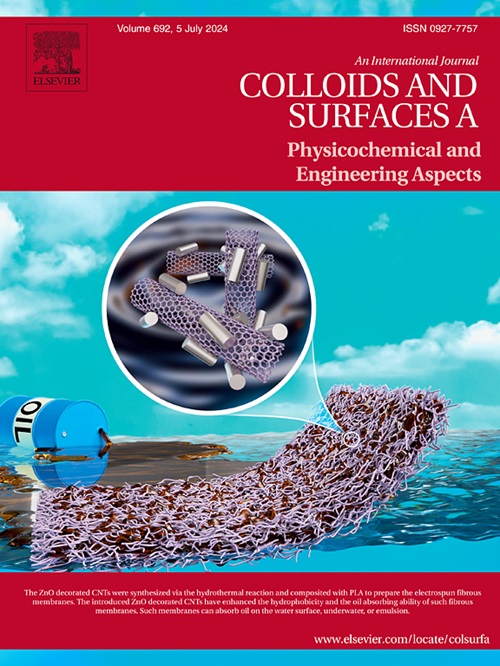Layered double hydroxides-derived CoNi alloy nanoparticles encapsulated by porous N-doped carbon nanofibers as efficient methanol electrocatalysts for alkaline direct methanol fuel cells
IF 4.9
2区 化学
Q2 CHEMISTRY, PHYSICAL
Colloids and Surfaces A: Physicochemical and Engineering Aspects
Pub Date : 2024-11-05
DOI:10.1016/j.colsurfa.2024.135703
引用次数: 0
Abstract
The exploration of inexpensive electrocatalysts possessing high activity and increased stability to replace precious metal catalysts in the methanol oxidation reaction (MOR) is highly desirable for alkaline direct methanol fuel cells (ADMFCs). This study presents a novel approach to synthesize layered double hydroxides (LDHs)-derived CoNi alloy nanoparticles confined within porous N-doped carbon nanofibers (CoNi@NCNFs) via facile electrospinning and pyrolysis for methanol electrooxidation. The one-dimensional N-doped carbon nanofibers could effectively prevent nanoparticle agglomeration during the pyrolysis of LDH precursors. The optimized CoNi@NCNF3–900 composite exhibits exceptional catalytic activity (80.3 mA cm−2) for MOR in alkaline solution, attributed to its hierarchical porous structure, high surface area, and abundant accessible active sites. Furthermore, the catalyst demonstrates competitive electrocatalytic stability, retaining over 90 % of its initial current density after 1000 consecutive cyclic voltammetry (CV) cycles. Notably, a single-cell ADMFC assembled with CoNi@NCNF3–900 as the anode catalyst achieves a promising maximum power density of 29.5 mW cm−2, highlighting the potential of CoNi@NCNF3–900 for application in DMFC technology and clean energy sources.
多孔 N 掺杂碳纳米纤维包裹的层状双氢氧化物衍生 CoNi 合金纳米粒子作为碱性直接甲醇燃料电池的高效甲醇电催化剂
在碱性直接甲醇燃料电池(ADMFC)中,探索具有高活性和更高稳定性的廉价电催化剂以取代甲醇氧化反应(MOR)中的贵金属催化剂是非常理想的。本研究提出了一种新方法,通过简便的电纺丝和热解工艺,在多孔掺杂 N 的纳米碳纤维(CoNi@NCNFs)中合成层状双氢氧化物(LDHs)衍生的 CoNi 合金纳米颗粒,用于甲醇电氧化反应。一维 N-掺杂碳纳米纤维可有效防止 LDH 前驱体热解过程中的纳米粒子团聚。优化后的 CoNi@NCNF3-900 复合材料对碱性溶液中的 MOR 具有优异的催化活性(80.3 mA cm-2),这归功于其分层多孔结构、高比表面积和丰富的可访问活性位点。此外,该催化剂还表现出极具竞争力的电催化稳定性,在连续 1000 个循环伏安法(CV)周期后,其初始电流密度仍保持在 90% 以上。值得注意的是,用 CoNi@NCNF3-900 作为阳极催化剂组装的单电池 ADMFC 达到了 29.5 mW cm-2 的最大功率密度,这凸显了 CoNi@NCNF3-900 在 DMFC 技术和清洁能源方面的应用潜力。
本文章由计算机程序翻译,如有差异,请以英文原文为准。
求助全文
约1分钟内获得全文
求助全文
来源期刊
CiteScore
8.70
自引率
9.60%
发文量
2421
审稿时长
56 days
期刊介绍:
Colloids and Surfaces A: Physicochemical and Engineering Aspects is an international journal devoted to the science underlying applications of colloids and interfacial phenomena.
The journal aims at publishing high quality research papers featuring new materials or new insights into the role of colloid and interface science in (for example) food, energy, minerals processing, pharmaceuticals or the environment.

 求助内容:
求助内容: 应助结果提醒方式:
应助结果提醒方式:


